Serving 237 students in grades 6-12, Pivot Charter School ranks in the bottom 50% of all schools in Florida for overall test scores (math proficiency is bottom 50%, and reading proficiency is bottom 50%).
The percentage of students achieving proficiency in math is 20-24% (which is lower than the Florida state average of 52%). The percentage of students achieving proficiency in reading/language arts is 35-39% (which is lower than the Florida state average of 52%).
The student:teacher ratio of 16:1 is lower than the Florida state level of 17:1.
Minority enrollment is 75% of the student body (majority Hispanic), which is higher than the Florida state average of 65% (majority Hispanic).
Quick Stats (2025)
- School Type: Charter School
- Grades: 6-12
- Enrollment: 237 students
- Student:Teacher Ratio: 16:1
- Minority Enrollment: 75%
- Graduation Rate: ≥90% (Top 50% in FL)
- Overall Testing Rank: Bottom 50%
- Math Proficiency: 20-24% (Btm 50%)
- Reading Proficiency: 35-39% (Btm 50%)
- Science Proficiency: 35-39% (Btm 50%)
- Source: National Center for Education Statistics (NCES), FL Dept. of Education
Top Rankings
Pivot Charter School ranks among the top 20% of public schools in Florida for:
Category
Attribute
Diversity
Community Size
School Overview
Pivot Charter School's student population of 237 students has declined by 8% over five school years.
The teacher population of 15 teachers has stayed relatively flat over five school years.
School Type
Grades Offered
Grades 6-12
Total Students
237 students
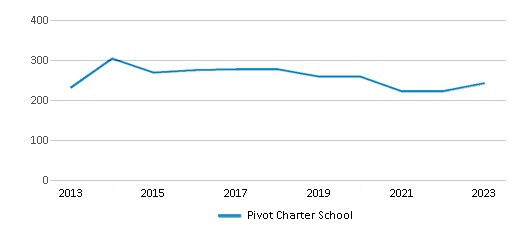
Gender %

Total Classroom Teachers
15 teachers
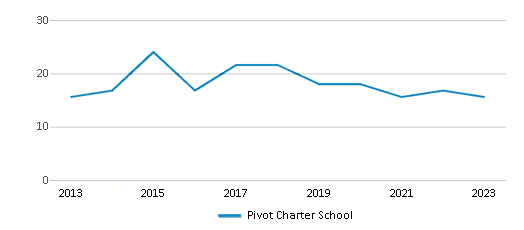
Students by Grade
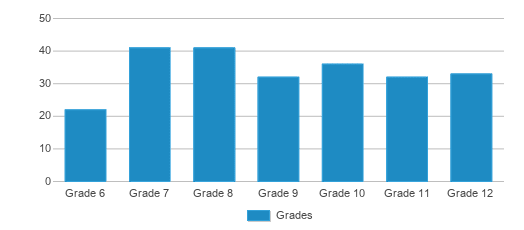
School Calendar
School Rankings
Pivot Charter School ranks within the bottom 50% of all 3,704 schools in Florida (based off of combined math and reading proficiency testing data).
The diversity score of Pivot Charter School is 0.72, which is more than the diversity score at state average of 0.70. The school's diversity has stayed relatively flat over five school years.
Overall Testing Rank
#3184 out of 3704 schools
(Bottom 50%)
(Bottom 50%)
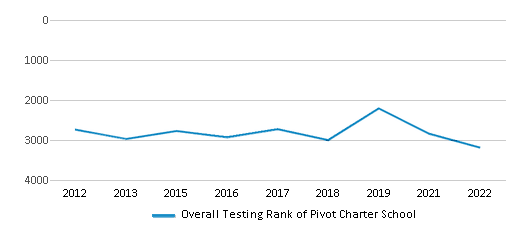
Math Test Scores (% Proficient)
20-24%
52%
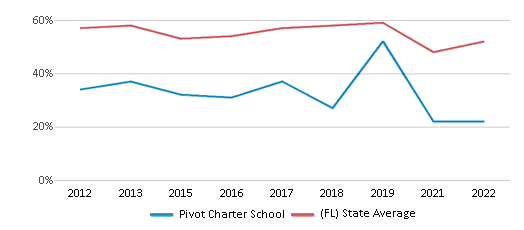
Reading/Language Arts Test Scores (% Proficient)
35-39%
52%
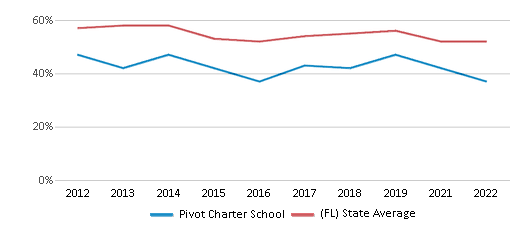
Science Test Scores (% Proficient)
35-39%
52%
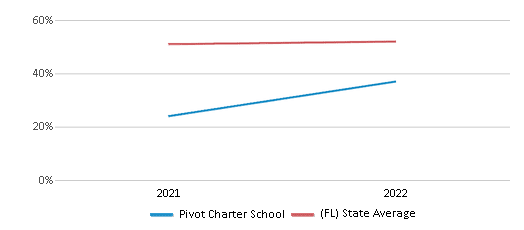
Student : Teacher Ratio
16:1
17:1
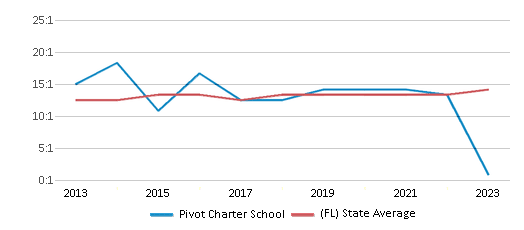
American Indian
n/a
n/a
Asian
2%
3%
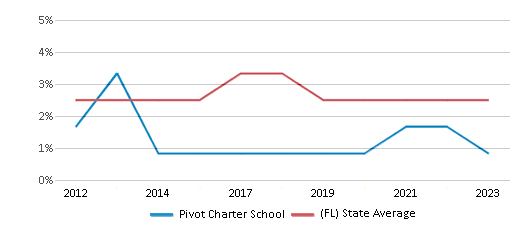
Hispanic
41%
37%
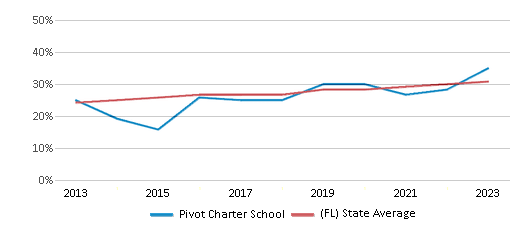
Black
21%
21%
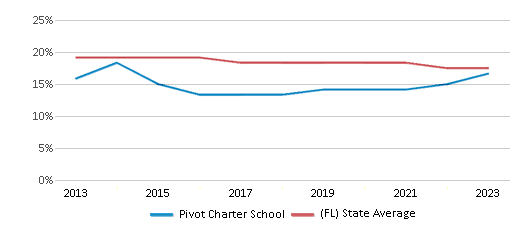
White
25%
35%
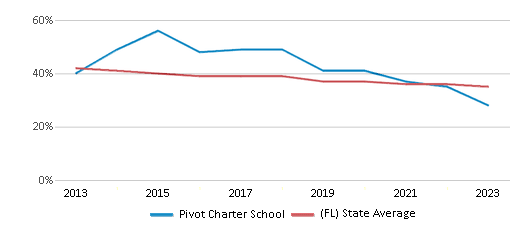
Hawaiian
1%
n/a
Two or more races
10%
4%
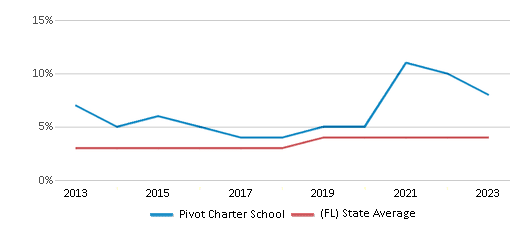
All Ethnic Groups
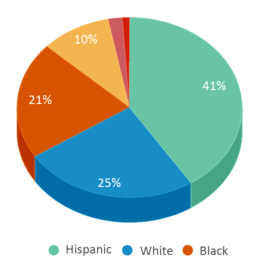
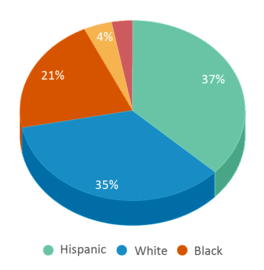
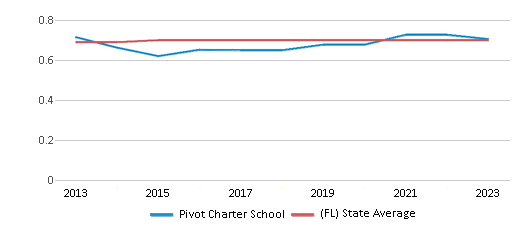
Graduation Rate
≥90%
87%
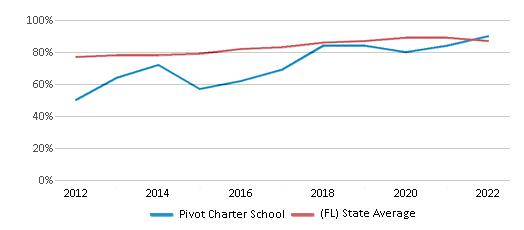
Eligible for Free Lunch
47%
47%

Eligible for Reduced Lunch
10%
4%

School Statewide Testing
School District Name
Source: National Center for Education Statistics (NCES), FL Dept. of Education
Profile last updated: 02/09/2025
Frequently Asked Questions
What is Pivot Charter School's ranking?
Pivot Charter School is ranked #3184 out of 3,704 schools, which ranks it among the bottom 50% of public schools in Florida.
What percent of students have achieved state testing proficiency in math and reading?
20-24% of students have achieved math proficiency (compared to the 52% FL state average), while 35-39% of students have achieved reading proficiency (compared to the 52% FL state average).
What is the graduation rate of Pivot Charter School?
The graduation rate of Pivot Charter School is 90%, which is higher than the Florida state average of 87%.
How many students attend Pivot Charter School?
237 students attend Pivot Charter School.
What is the racial composition of the student body?
41% of Pivot Charter School students are Hispanic, 25% of students are White, 21% of students are Black, 10% of students are Two or more races, 2% of students are Asian, and 1% of students are Hawaiian.
What is the student:teacher ratio of Pivot Charter School?
Pivot Charter School has a student ration of 16:1, which is lower than the Florida state average of 17:1.
What grades does Pivot Charter School offer ?
Pivot Charter School offers enrollment in grades 6-12
What school district is Pivot Charter School part of?
Pivot Charter School is part of Hillsborough School District.
School Reviews
5 10/6/2021
This has been a wonderful school for my child! My child loves that it's a smaller school. I love that the teachers take time to get to know my child!
1 7/23/2020
Been going to this school for years, the students there are basically all there. Because it's their last option before being sent to an alt school, there is so much drama for how small the school is and the teachers unfairly grade the work.
5 12/6/2016
My son has always been a good student but has some social anxiety. Pivot has been a blessing for him. He is learning there as his PSAT shoes a very high score. There is a measure of self reliance so poorPerformers may not be able to succeed here but if you are a good student who has plans for your future and don't want a much of drama Pivot is a great choice. At his precious school there were daily fights, not at Pivot. I don't know if you can find any school without drugs but I know there are children who have been kicked out for bringing drugs to school so that's good. There aren't any cheerleader princesses or testosterone filled jockeys wich for the average student is a plus. The staff is the most hands on and concerned for his success then he's ever had. It's a great place to send your child.
2 8/1/2015
I agree with your comments AMEN to that. Very disorganized and rude teachers.
2 12/19/2014
So let me start off by saying that I have always been a student who loved school and got A's and B's. But a problem I have always had is my anxiety levels in social situations. My Dad and I thought we should give Pivot a go after looking through many highschools in Florida. It seemed low-key, the students would get 1-on-1 attention, and it was a self-motivated system which I had no problem with.
I went there for a year and a half and let me tell you about my experience-
The systems were terribly unorganized. Kids would walk off to whatever class wherever they wanted and the teachers didn't care. When I first enrolled, the teachers kept screwing with my schedule and passing me off to other teachers so they would have less work to deal with. Any special days or events that were going on were poorly coordinated and weren't mentioned until the day before.
Second, the majority of students going there were basically going as a last resort because of their non-caring attitude and bad grades. They would sit at their cubicle doing nothing and disrespect all the teachers who turned a blind eye. I remember when I was once doing my work and a girl and boy were talking about all the drugs they have taken and the girl passed him a small bag of weed right out in the open and nobody did anything. All the students abused the uniform policy and again the teachers did nothing.
I honestly think most of the teachers lacked teaching skills and only came for a paycheck. And if you see a current student trying to convince you how good it is, it's because they do these things where if a student gets somebody to go there, they get some free cool prize.
It is not a good environment to be working in.
Overall, this school is a disorganized and terrible system and I wouldn't recommend this to anyone.
Review Pivot Charter School. Reviews should be a few sentences in length. Please include any comments on:
- Quality of academic programs, teachers, and facilities
- Availability of music, art, sports and other extracurricular activities
Recent Articles

What Is A Charter School?
Explore the world of charter schools in this comprehensive guide. Learn about their history, how they operate, and the pros and cons of this educational innovation. Discover key facts about charter schools, including admission policies, demographics, and funding, as well as what to look for when considering a charter school for your child.

10 Reasons Why High School Sports Benefit Students
Discover the 10 compelling reasons why high school sports are beneficial for students. This comprehensive article explores how athletics enhance academic performance, foster personal growth, and develop crucial life skills. From improved fitness and time management to leadership development and community representation, learn why participating in high school sports can be a game-changer for students' overall success and well-being.

February 05, 2025
Understanding the U.S. Department of Education: Structure, Impact, and EvolutionWe explore how the Department of Education shapes American education, from its cabinet-level leadership to its impact on millions of students, written for general audiences seeking clarity on this vital institution.









